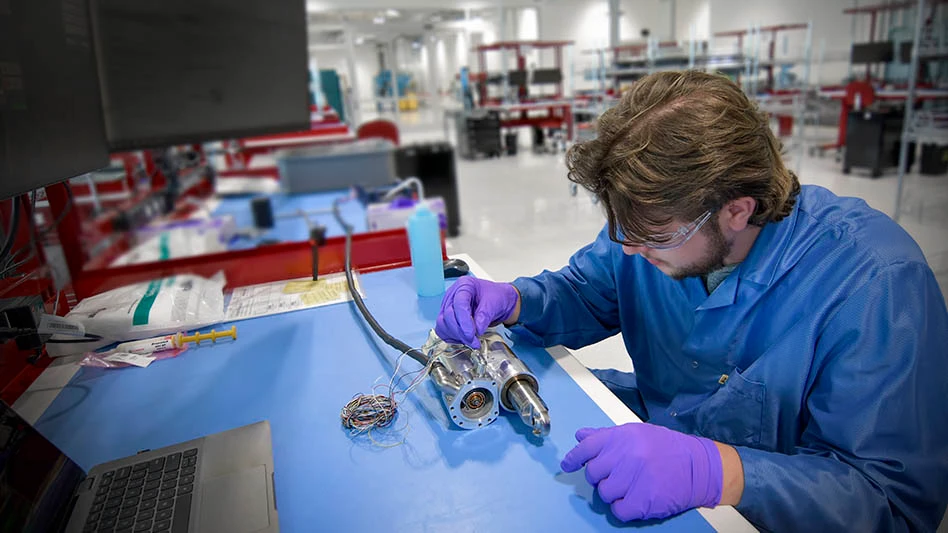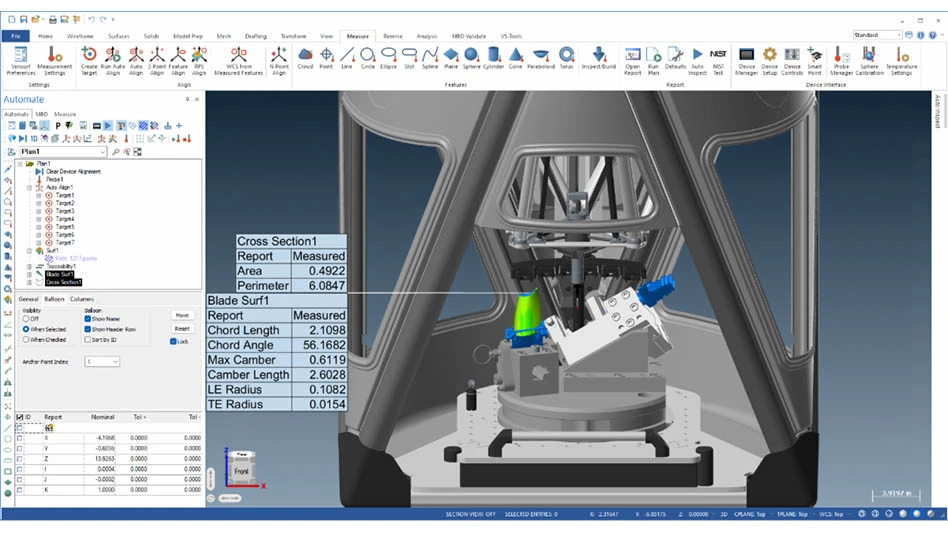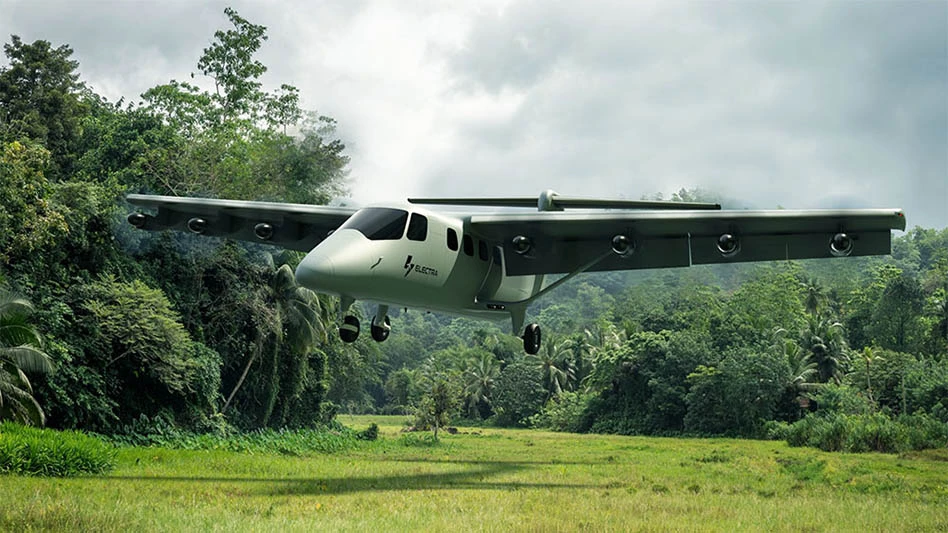
Advanced CNC programming software that can handle complex shapes has allowed prototype manufacturer Morris Technologies Inc, Cincinnati, OH, to double its revenues. The software enables the company to take on jobs that would be too time-consuming to program by hand.
"Programming complicated parts by hand does not work for customers who need to prove out a design," explains Doug Burns, a prototyping machinist at Morris Technologies. "They need fast turnaround. With ESPRIT (from DP Technology), we can write programs for 4-axis wire electrical discharge machining in 10 to 15 minutes. Most programs for the 4-axis lathes take about an hour. This is many times faster than we could do by hand."

An array of prototype parts produced by Morris Technologies.
ESPRIT supports the company's use of Direct Metal Laser Sintering (DMLS), a revolutionary technology that produces prototypes in a fraction of the time of conventional processes. ESPRIT is used to quickly write programs for DMLS parts that need subsequent machining.
Morris Technologies was founded in 1994. The company produces prototype parts and short runs for customers in the aerospace, medical, automotive, and consumer products industries. It excels at complex, multi-axis type of parts and works with many materials including aluminums, steels, plastics, composites, foams and exotic metals. In addition to highly advanced CNC machining and rapid prototyping, the company offers a broad range of product development services including engineering and design, rapid tooling and injection molding, and urethane reproductions.
Leading with Technology
Another factor contributing to the company's success is its use of state-of-the-art equipment and leading-edge technologies. Its equipment lineup includes machines from manufacturers such as Mori Seiki, Marubeni Citizen-Cincom, Charmilles, Belmont, Extrude Hone, and others. Morris Technologies is also the leading North American provider of DMLS, which the company has offered since 2003. Well known outside the U.S., DMLS is now beginning to gain recognition here. It is an "additive" technology that builds parts by sintering very fine layers of metal powders layer-by-layer from the bottom up until the part is complete.
Morris Technologies was the first company in North America to acquire this technology. The company uses it primarily for smaller, complex parts that would be time-consuming and expensive to make using other, more traditional methodologies.
"This is something unique about us," Burns explains. "We generally don't make a part by just cutting metal. We use DMLS to grow it and then if necessary we'll machine it."
Applications are wide-ranging and include inserts for plastic injection molding and die casting as well as direct parts for a variety of applications in all the industries the company serves. With the emergence of advanced materials such as the super alloy cobalt chromium (CoCr) and 17-4 PH Stainless, coupled with the design freedoms this technology offers, new applications are constantly being discovered. In some cases, DMLS can make parts that previously could not be made any other way.
Machining After DMLS
Most DMLS parts require some machining to meet customers' levels of precision. When this is the case, the company uses horizontal production machining (Mori-Seiki NH 4000) or vertical CNC mills, lathes (including new Swiss Turning capability) and EDM (wire & plunge) to complete the part. In the past, the company used CNC programming software that could handle 3-axis equipment. With the growing complexity of the parts produced with DMLS (and the more advanced, 4-axis equipment to machine them) came the need for more advanced programming software. Burns, whose job it is to program the 4-axis machines, writes "probably one program a day," he says. He was involved in the selection of the new software.
"ESPRIT was chosen because it can handle complex shapes," he says. "Another advantage is that it can run every machine we have and every machine we will purchase in the future. We chose ESPRIT because we wanted one piece of software that could handle everything, rather than five or six different programs."
The process of creating a DMLS part that requires subsequent machining begins with the receipt of customer's solid model in STEP or IGES format. Working from the customer's data is beneficial to both parties, as Burns explains. "Because ESPRIT allows us to work directly from the solid models, our customers do not have to spend time creating prints, which in turn allows us to get their parts manufactured faster. This allows us to provide value to our customers by reducing the amount of work they have to do."

DMLS impellers produced by Morris Technologies.
Burns imports this into ESPRIT, where he quickly applies preliminary toolpaths to the geometry to get an idea of how long the job will take. Based on that information, he prepares the quote. When the company gets the job, Burns begins the process of creating the actual toolpaths that will be used to manufacture the part. In the case of parts that will be machined on the lathe, he selects the ESPRIT feature that automatically creates a turning profile. Many parts that he makes are half round and half square.
"ESPRIT looks at the solid model and realizes what can be turned and which part is square," he explains. "It adjusts the turning so that it doesn't violate the square, which we go back and mill later."
ESPRIT's knowledge-based machining capabilities remove much of the manual drudgery from programming and enable programmers to focus much more time and attention on higherlevel tasks such as optimizing machine productivity and maintaining quality. For example, the software's feature recognition capability enables it to divide the surfaces of incoming geometry into logical sections that are ready to be assigned cutting tools. When this capability is combined with previously created machining operations, creating a toolpath is almost automatic. The programmer simply opens the ESPRIT library and drags and drops operations onto the features the software has identified.
"The advantage of feature recognition is that you can create machine instructions for frequently used features and ESPRIT will automatically apply them to the features it identifies," explains Burns.
Burns often takes advantage of ESPRIT's ability to manually create features and establish machining operations. After creating the features, he assigns the tool and selects the type of milling operation by filling in the software's set-up page. He also takes advantage of the software's ability to simulate the machining process on the screen, allowing him to make sure there are no crashes and that the machine operates as it's supposed to.
The programming process is a bit different for wire EDM. Burns still imports the customer's model and orients it for manufacturing. For 2-axis wire EDM, he manually applies the chain feature to the part, which identifies what will actually be cut by the wire. ESPRIT has an add-in utility that integrates it with the company's Charmilles machine. Using that utility, Burns works with the Charmilles machine's technology files (the settings for the burn) within ESPRIT. After he enters these specifications, ESPRIT uses the information to offset the toolpath for the overburn of the wire.
With 4-axis wire EDM, upper and lower heads move independently of each other. In many cases it takes only a few mouse clicks to begin cutting parts on these machines because ESPRIT can recognize the solid model and apply toolpaths automatically. "In the more difficult cases, either bad solid models or really complex geometry, I manually define upper and lower toolpaths," Burns explains. "Then I link them together. ESPRIT recognizes if I am doing a 4-axis cut or taper cut."
The "Unmanufacturable"
ESPRIT supports Morris Technologies' strategy of using the most advanced manufacturing equipment available. ESPRIT is allowing Morris to take on new capabilities such as 4-axis wire EDM and 4-axis lathes. With the ability to create CNC programs for all but the most unique shapes in less than an hour, ESPRIT also supports Morris Technologies' mission to respond rapidly to its customers' requests.
ESPRIT is also helping the company win business no matter how complex the parts involved. "ESPRIT has allowed us to manufacture parts that would otherwise be impossible to manufacture by conventional methods," says Burns. Programs written on ESPRIT account for approximately one-half of Morris Technologies' machining work, which means that the software has helped the company double its revenues.
Get curated news on YOUR industry.
Enter your email to receive our newsletters.

Explore the March April 2008 Issue
Check out more from this issue and find your next story to read.
Latest from Aerospace Manufacturing and Design
- Demystifying Controlled Unclassified Information (CUI)
- Simplify your shop floor operations while ensuring quality parts
- Happy Independence Day - July 4th
- Bombardier receives firm order for 50 Challenger, Global jets
- Automatic miter bandsaw
- SAS orders 45 Embraer E2 jets with options for 10 more
- Height measuring instrument
- Shopfloor Connectivity Roundtable with Renishaw & SMW Autoblok






